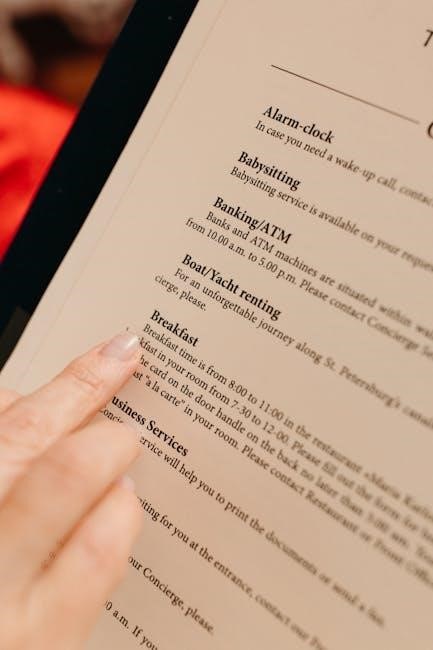Boat guides are essential for efficient, safe trailer loading. They align boats precisely, reduce damage risk, and simplify the process for a stress-free experience;
What Are Boat Guides for Trailers?
Boat guides for trailers are systems designed to assist in aligning and securing a boat during loading and unloading. These guides typically consist of rollers, carpeted surfaces, or automated mechanisms that help center the boat on the trailer. They reduce the risk of damage to the boat or trailer and make the process safer and more efficient. Available in various types, such as roller or carpeted guides, they cater to different boat sizes and preferences. By providing clear alignment, they simplify the docking process, ensuring a stress-free experience for boat owners. These systems enhance trailer functionality and boat protection.
Why Are Boat Guides Essential for Safe and Efficient Loading?
Boat guides are crucial for ensuring safe and efficient loading by providing clear alignment and stability. They minimize the risk of damage to the boat or trailer during the process. By guiding the boat accurately onto the trailer, they reduce the likelihood of accidents and misalignment. This not only protects the vessel but also saves time and effort. Additionally, guides enhance safety by preventing the boat from shifting, ensuring a secure fit. Their role in streamlining the loading process makes them indispensable for boat owners seeking convenience and protection.

Types of Boat Guides for Trailers
Boat guides come in various types, including roller, carpeted, manual, and automated systems. Each design offers unique benefits for alignment, support, and ease of use during loading.
Roller Guides vs. Carpeted Guides
Roller guides feature smooth, rounded surfaces that allow boats to slide effortlessly onto trailers, reducing friction and wear. Carpeted guides, covered with durable, non-abrasive material, provide a gentle grip, protecting the hull from scratches. Rollers are ideal for frequent use and heavy boats, while carpeted guides are better for smaller vessels and those requiring extra protection. Both options enhance loading efficiency but cater to different needs and preferences, ensuring safe and damage-free boat handling.
Manual vs. Automated Boat Guides
Manual boat guides require physical alignment and adjustment, offering simplicity and cost-effectiveness for occasional use. Automated systems, however, provide advanced convenience, adjusting automatically for precise alignment. Manual guides are ideal for smaller boats and budget-conscious owners, while automated systems suit frequent users seeking efficiency. Both options enhance safety and ease, but automation offers superior speed and accuracy, making it a worthwhile investment for those prioritizing convenience and precision in their boating routine.

How to Choose the Right Boat Guide System
Assess your boat’s size, type, and weight to select the ideal guide system. Consider durability, ease of use, and whether manual or automated suits your needs best.
Factors to Consider: Boat Size, Type, and Weight
When selecting a boat guide system, consider your boat’s size, type, and weight. Larger boats require sturdier guides, while smaller boats may need lighter options. Fishing boats and yachts differ in loading needs. Weight distribution is crucial to ensure stability during loading. Assessing these factors helps match your boat with the most suitable guides, enhancing safety and efficiency. Compatibility with your trailer and guide system is also key for optimal performance and longevity.
Material and Durability: Which Option is Best?
Boat guide materials vary, with options like plastic, aluminum, or carpeted systems. Aluminum guides are durable and long-lasting, while carpeted ones protect your boat’s hull from scratches. Plastic guides are lightweight but may wear faster. Consider your boat’s size, usage frequency, and environmental conditions. Durable materials like stainless steel or galvanized options resist rust, ensuring longevity. Choose based on your specific needs for strength, corrosion resistance, and maintenance preferences to ensure optimal performance and protection for your boat.

Installation and Maintenance
Proper installation ensures alignment and safety, while regular checks maintain durability. Seasonal adjustments and cleaning prevent wear, ensuring optimal performance and longevity of your boat guide system.
Step-by-Step Installation Guide
Begin by measuring your trailer’s frame to determine guide placement. Mark the mounting points and drill pilot holes. Secure the guides using bolts, ensuring tightness. Adjust the guides to align with your boat’s hull. Test the system by loading the boat slowly, checking alignment. Tighten all connections after successful testing. Regularly inspect and maintain the guides for optimal performance and longevity.
Regular Maintenance Tips for Longevity
Regularly lubricate moving parts to prevent rust and friction. Inspect guides for wear or damage, replacing components as needed. Clean debris from rollers or carpeted surfaces to ensure smooth operation. Protect metal parts from corrosion with a rust-inhibiting coating. Check alignment and tighten bolts periodically. Store guides in a dry, protected area during off-seasons to prevent deterioration. Proper maintenance ensures durability and optimal performance, extending the lifespan of your boat guide system.
Safety Tips When Using Boat Guides
Ensure the area is clear of obstacles. Secure the boat firmly to the trailer. Use proper alignment and check guides for damage before loading.
Precautions to Avoid Damage to Your Boat or Trailer
Regularly inspect boat guides for wear or damage. Clean and lubricate moving parts to ensure smooth operation. Use padded guides to protect the boat’s hull from scratches. Always align the boat correctly before loading to prevent misplacement. Avoid over-tightening, as this can strain the trailer or boat. Perform maintenance checks on the trailer’s frame and axles to ensure stability. Properly secure the boat with straps and ropes to prevent shifting during transport. Address any issues promptly to avoid costly repairs later.
Common Mistakes to Avoid
Improper alignment, failing to use padded guides, and neglecting maintenance are common errors. Overloading and ignoring trailer balance can also lead to unsafe loading conditions and damage.
Pitfalls to Watch Out for When Loading Your Boat
Improper alignment with the trailer can cause misguidance, leading to potential damage or accidents. Moving too quickly without guidance increases the risk of boat or trailer misalignment. Additionally, failing to secure the boat properly after loading can result in shifting during transport, compromising safety. Overlooking these pitfalls can lead to costly repairs, injuries, or even accidents. Always ensure the boat is centered, guides are functioning, and the load is secure before moving. Proper preparation prevents unnecessary risks and ensures a smooth experience.

Advantages of Using Boat Guides
Boat guides simplify loading by improving alignment, protecting the hull, reducing stress, and minimizing potential damage, ensuring a safer and efficient experience every time.
How Guides Enhance Your Boating Experience
Boat guides streamline the loading process, reducing stress and saving time. They protect your vessel from scratches and damage, ensuring a seamless transition to the water. By providing precise alignment, guides prevent costly repairs and extend the life of your boat. This enhances overall safety and allows you to focus on enjoying your time on the water, making every boating excursion more pleasurable and worry-free.

Cost and Budgeting
Boat guide systems vary in price, with basic models starting at $50 and premium options up to $300. Factors like material quality and automation influence costs, offering a balance between budget and functionality.
Understanding the Price Range and Value
Boat guide systems range from $50 to $300, offering diverse options tailored to different budgets. Basic models provide essential functionality at lower costs, while premium systems include advanced features like automation and durability. Higher-priced systems may offer enhanced materials, such as heavy-duty steel or rust-resistant coatings, ensuring longevity and better performance. Assessing specific needs helps determine the best value, balancing cost with functionality for optimal satisfaction. Quality and durability often justify higher investments, providing long-term benefits.
Customer Reviews and Ratings
Boat guides receive high satisfaction ratings, praised for ease of use and durability. Many users highlight their effectiveness in aligning boats and reducing loading stress, recommending them widely.
What Other Boat Owners Are Saying
Boat owners praise guides for trailers, noting ease of use and durability. Many highlight reduced stress during loading and unloading, with several recommending specific models for their effectiveness. Some users mention that high-quality guides prevent scratches and dings, while others appreciate the time-saving benefits. A few note that automated systems are worth the investment for consistent alignment. Overall, positive feedback underscores the practical value of boat guides in enhancing the trailer loading experience.

Troubleshooting Common Issues
Address alignment problems by adjusting guide positions. Replace worn-out rollers or carpeting. Check for loose bolts and tighten them. Regular lubrication prevents corrosion and ensures smooth operation.
Solving Problems with Your Boat Guide System
Identify common issues like misalignment or wear. Inspect guides for damage and clean debris. Lubricate moving parts to prevent rust. Tighten loose fasteners and replace worn components. Ensure proper installation to avoid recurring problems. Regular maintenance prevents system failure. If issues persist, consult a professional for adjustments or repairs. Keep guides aligned to protect your boat and trailer during loading and unloading.
Boat guides for trailers enhance loading efficiency, safety, and protect your vessel. Invest in a reliable system to ensure hassle-free boating experiences and maintain your equipment’s longevity.

